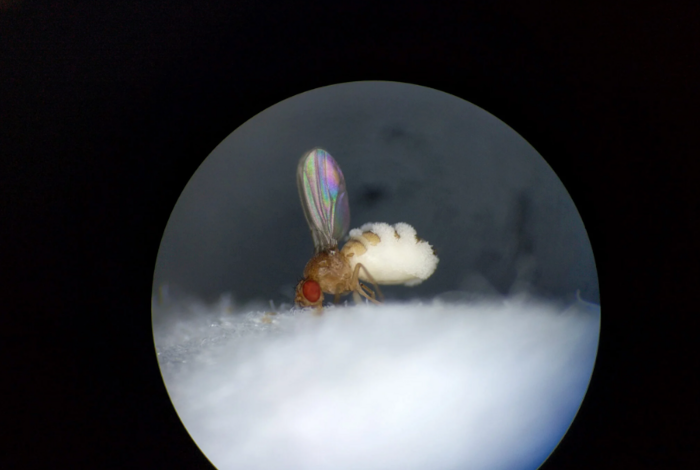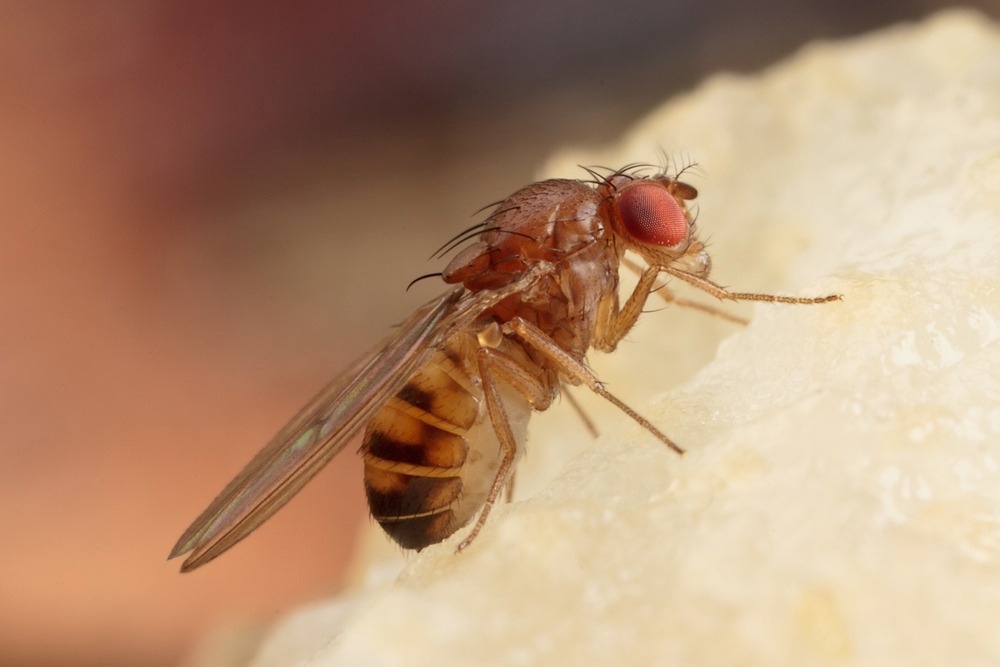Reviewed by Danielle Ellis, B.Sc.May 22 2023
Carolyn Elya, a Postdoctoral Researcher in the Department of Organismic and Evolutionary Biology at Harvard, illustrates the molecular and cellular underpinnings of the parasitic fungus Entomophthora muscae’s (E. muscae’s) ability to influence the behavior of fruit flies in new research published in eLife.
 Fruit fly with its wings up and evidence of a fungal outgrowth. Image Credit: Carolyn Elya.
Fruit fly with its wings up and evidence of a fungal outgrowth. Image Credit: Carolyn Elya.
Elya initially revealed the altered behavior, known as summiting, in a 2018 study published in eLife. Elya, a graduate student at the University of California (UC) Berkeley, laid out rotting fruit to capture wild fruit flies while researching microorganisms carried by fruit flies.
When she went back to see if she had caught any, she discovered zombie flies with a banding pattern on their abdomen that had died in an unusual pose. Elya validated the probable cause, E. muscae, through DNA extraction and sequencing.
At sunset, the infected flies ascend to a high place and extend their proboscises to the surface. The fly is adhered to the surface by a sticky droplet that comes from the proboscis just before the wings elevate up and away from the body and the flies die.
The climbing is very important as it positions the fly in an advantageous location for the fungus to spread to the most possible hosts. The fungus jumps to the new host by forming very specialized and temporary structures that burst through the fly’s skin and shoots spores into the environment that are only good for a handful of hours. It’s a fleeting process, so an advantageous position is everything to survival.”
Carolyn Elya, Postdoctoral Researcher, Department of Organismic and Evolutionary Biology, Harvard University
Using a wild fungal isolate she found in her backyard, Elya created a laboratory model she calls the Entomophthora muscae-Drosophila melanogaster “zombie fly” system while researching at UC Berkeley. Elya could use this method to continuously infect fruit flies, a laboratory staple, as well as culture the fungus independently of the fly host in a medium supposed to imitate the fly’s internal environment.

Image Credit: Ant Cooper/Shutterstock.com
Summiting has been mentioned in scientific literature multiple times, although the investigations had just been observations of dead house flies. Nobody had ever seen how flies act in their final hours of life.
Elya set out to close the knowledge gap about what happens when flies summit by inventing a high-throughput behavioral experiment that tracks hundreds of infected flies automatically. She encountered a surprise when using this platform to track the behavior of flies turning zombies.
We found that summiting is not about climbing, it’s actually this burst of locomotor activity that starts about two and a half hours before the flies die.”
Carolyn Elya, Postdoctoral Researcher, Department of Organismic and Evolutionary Biology, Harvard University
With this discovery, Elya and her team combined her system for producing on-demand zombie flies with the lab's powerful fruit fly genetic toolkit. With these and the author’s new behavior assay researchers could recognize genes and neurons needed for flies to summit.
“Overall, we found the flies hormonal axes was mediating summiting behavior. When we silenced these neurons the flies were really bad at summiting,” Elya notes. These neurons provide projections to a neurohemal organ, which produces a juvenile hormone, an insect-specific hormone.
We think the fungus is actually driving the activity of these neurons in order to drive the release of this hormone, which is causing the flies to have this burst of locomotor activity.”
Carolyn Elya, Postdoctoral Researcher, Department of Organismic and Evolutionary Biology, Harvard University
Elya and co-workers were then able to collect a behavioral dataset of hundreds of infected flies, which they used to instruct a computer to detect flies while summiting. Using this classifier tool, the researchers discovered that fungal cells enter the brains of flies in a systematic manner, occupying certain parts of the brain during summiting.
Surprisingly, the study discovered that when exposed to the fungus, the flies' blood brain barrier is weakened. Normally, the neurons are shielded from the blood that circulates throughout the body of the fly. The breakdown of the blood-brain barrier has significant implications for what neurons are exposed to, potentially allowing substances circulating in the blood to interact with neurons in the brain, giving a channel for influencing neuronal activity.
“We think this could be important for the way that the fungus is driving behavioral changes, and we actually found that you can pull blood from flies that are doing the summiting behavior, put it into naive flies, and drive some of this increased locomotion. So we've shown that there's at least the partial ability to recapitulate this summiting behavior just by transferring fly blood,” Elya notes.
According to Elya, these experiments suggest that some blood-borne substances can influence summiting behavior, however, it is not yet obvious what these factors are or who produces them (the fungus or the fly).
In addition to the perturbations that can currently be created in the flies, Elya hopes to develop transgenics to help modulate things from the fungus side. “There are still a lot of open questions here, what the fungus is doing is still a mystery,” Elya says.
Source:
Journal reference:
Elya, C., et al. (2023). Neural mechanisms of parasite-induced summiting behavior in “zombie” Drosophila. ELife. doi.org/10.7554/eLife.85410.